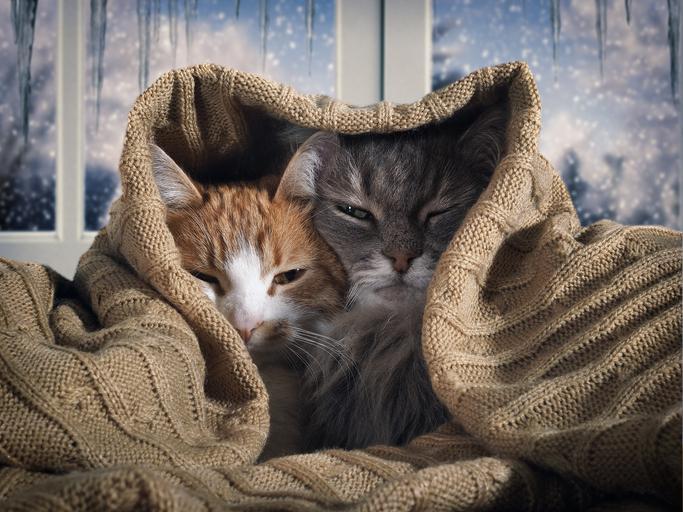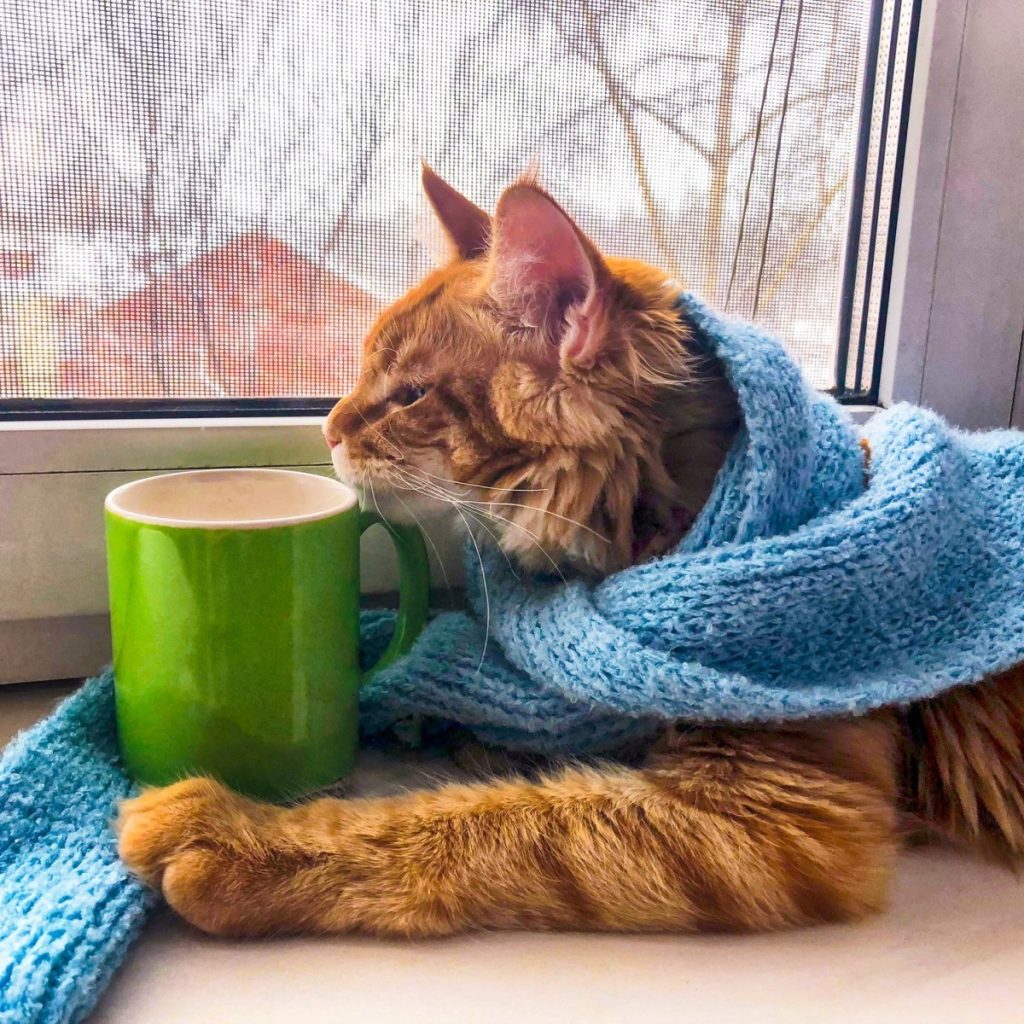Table of Contents
The cat in winter – Hot tips for cold days
Nature has provided cats with a cozy fur coat. Nevertheless, cold temperatures in winter can make things difficult for them. If the outdoor cat is out and about in ice and snow , you can definitely help him get through the winter and defy the cold. So that the kitty can enjoy life to the full even when the temperature drops to zero.
Can cats survive outside in winter?
As a rule, cats can survive outside in winter. But the colder it gets, the more problematic it can be for your furry friend, especially if it is not only outdoors but often also as a house cat. How well your cat tolerates the cold temperatures also depends on its age, state of health and available shelter options . Depending on the cat and the temperature, you should take precautions or consider whether the kitten should stay at home.

Do cats get cold in winter?
Despite the fur coat – even cats can freeze. How much cold a cat can withstand also depends on its constitution, age, health and weight. Outdoor cats with a dense winter coat are more likely to defy ice and snow than house tigers with an occasional fresh air supply. At temperatures below minus 20 degrees, it becomes uncomfortable even for thick-skinned cats. Especially wet fur can lead to life-threatening hypothermia . Even if your cat is equipped with a plush winter coat, you should take action when the temperature is below freezing: either bring your cat inside or set up a cozy cat house outside, which protects your cat from hypothermia.
For indoor cats that are rarely outside, temperatures below 5 degrees can already be too cold. Some house cats also freeze indoors in winter. The benchmark here is: If you shiver, the cat could also be too cold. The only thing that helps: turn up the heating. And lots of cuddles!
How to deal with cold temperatures outside
Kittens and old cats have little to oppose the winter. If the temperature is below 5 degrees, you should stay indoors. In addition, it is easier for them to lose their orientation in the snow and not find their way home.

Cats in the cold weather
Even if healthy cats can usually survive outside in winter without any problems, you should heed a few tips. The cold poses some challenges for the cat – with your help, it will face them with ease!
How you can keep the cat warm in winter
- Make sure you have enough food and water : When it’s cold, cats use more energy when they go outside. It can therefore be advisable to increase the amount of food in winter, as many cats eat more at this time of year. Fresh water that is freely available should also always be available.
- Wet food consumes less energy when eaten, but can freeze. If your cat eats outdoors, dry food is the ice-free option of choice in sub-zero temperatures.
- Food in deep bowls freezes less quickly than food in shallow ones. Avoid metal bowls, they freeze particularly quickly.
- You can warm up the water and wet food on the stove before putting it outside .
- Protect your cat’s paws with animal-friendly road salt or use shavings, gravel or sand instead of salt in icy temperatures. The conventional, commercially available one can injure the cat’s sensitive feet.
- Caution: Antifreeze is highly toxic to cats! Therefore, make sure that there are no leftovers within reach of your furry friend, so as not to damage their health.
When temperature is too cold for indoor cats
If your cat moves less indoors in winter, you should check whether the feeding amount is still correct in order to avoid obesity. In warm, heated apartments, cats often become more comfortable in winter. We know the problem from us two-legged friends: less sport means more pounds. This also applies to cats. So keep a close eye on the weight of your house tiger in winter!

Do cats sleep more in winter?
In fact, the answer is yes. The cold costs energy, which is why cats sleep an average of 20 hours a day in winter . Make sure there are snug berths for kitty beauty sleep. If your cat has just returned from a winter walk, put a hot-water bottle (not too hot and wrapped in a towel) by its favorite sleeping spot. Does your cat like to sleep outside even in winter? How about a winter-proof outdoor cat house?
The Winter Residence – A cat house for the cold season
Some hardened outdoor cats want to sleep outside even in winter. If your cat would rather be outside at night than come into the cozy and warm apartment, you can buy her a cat house for the winter as a shelter or you can make one yourself. Compared to buying cat houses, DIY has the advantage that it is usually cheaper and you can design it according to your visual ideas.
The cat house in winter – you should pay attention to this
The winter cat house should be well insulated and on feet to keep out the cold of the ground and moisture. The feet should be insulated with rubber. It should also have a small entrance door or opening protected with louvers or a cat flap. If you search the web for DIY instructions for a cat house in winter, you will often come across a shelter in a converted plastic box. Of course, a cat house made of wood is more sustainable and prettier. You can either build this yourself, or you can insulate a conventional cat house or dog house with cork or felt. You can cover the roof with roofing felt from the hardware store to winterize. Build the house for your cat in a wind and weather-protected location. For example near the wall of the house or in a corner of the fence.
The interior
There are special heating mats for cats on the market in winter, which ensure that the inside of the winter residence stays toasty and warm. In fact, cat houses with underfloor heating are also available! Straw, woolen blankets or a cozy sleeping bag are cheaper as protection against the cold. You should check the filling regularly for moisture and replace it if necessary so that no mold forms and it stays cozy and warm inside.
Recognizing and treating hypothermia in cats
Despite all measures and warm winter coats, cats can suffer from hypothermia. That doesn’t happen very often. The cold can be dangerous for the kitty, especially when the fur is no longer able to protect itself from heat due to moisture. Then quick action is required, because hypothermia can be fatal in the worst case!

These are the signs of hypothermia in the cat
- The body temperature is below 38 degrees
- Legs and paws feel cold
- The cat is shaking
- Cold shock: The pulse is racing, breathing is shallow , the mucous membranes are pale
Frostbite (frostbite) can also occur: after warming up, it appears as a red swelling, is painful and itchy. Blisters and skin sores can also develop. When the super cooled tissue dies, it turns black.
First aid for hypothermia
Cold shock in the cat is an emergency. If you suspect it, you should call a veterinarian immediately! If the cat shows slight signs of hypothermia, you should quickly bring the furry friend into the warmth. A hot water bottle (not too hot and wrapped in a towel) allows the body temperature to rise. You can also wrap the cat in a warm woolen blanket. If the cat’s fur is wet, you should ensure that it dries as quickly as possible. You can carefully shower off cold paws or the tip of the tail with warm water – but the water should never be hot. Warm water warms up the freezing furry friend from the inside.
Final thoughts
Even warm winter fur does not always reliably protect the cat from the cold. Older cats and kittens in particular quickly have problems on cold days. In winter you should therefore support your cat so that it can defy the frosty temperatures. From the DIY winter cat house to changing the food supply and avoiding hypothermia, you can do a lot for your furry friend even in the cold season. And if you feel like it, an extra cuddle will always help, of course, so that your hearts warm up very quickly!
Frequently Asked Questions
Q: How cold is too cold for a cat outside?
A: Cats can be susceptible to cold temperatures, and generally, anything below 45 degrees Fahrenheit can be too cold for outdoor cats. It’s important to notice your cat’s behavior and ensure they stay warm in cold temperatures. If you have feral or stray cats in your area, keep an eye on them as well, as they can also be affected by the cold.
Q: What are the signs of frostbite in cats?
A: Cats that spend a lot of time outside, especially during winter, can be at risk of frostbite. Some signs to look out for include paw pads that are whitish or bluish in color, and skin that’s cold to the touch. If you notice these signs, it’s essential to get your cat to a veterinary for a check-up.
Q: How can I help my cat stay warm in cold temperatures?
A: There are a few things you can do to help your cat stay warm in cold weather. Provide a cozy bed or bedding for them to curl up in, consider a sweater designed for cats, or create a warm and comfortable indoor space for them to retreat to when it’s too cold outside.
Q: What temperature is too cold for a cat?
A: If the temperature drops below 32 degrees Fahrenheit, it’s considered too cold for most cats. It’s crucial to pay attention to the weather and how your cat is behaving to ensure they don’t get too cold. Young cats, sick cats, and feral cats are even more susceptible to the cold.
Q: Are outdoor cats more prone to getting too cold?
A: Yes, outdoor cats, especially feral and stray cats, can be more prone to getting too cold. It’s essential for pet parents to keep an eye on outdoor cats during cold weather and provide them with options to stay warm and sheltered.
Q: Should I let my cat stay outside in cold weather?
A: It’s generally best to keep your cat inside during cold weather, especially when temperatures drop close to or below 45 degrees Fahrenheit. Even if your cat is used to being outdoors, it’s important to keep them inside to protect them from the cold.
Q: Can I provide a cat bed or bedding to help my cat stay warm?
A: Yes, providing a cat bed or cozy bedding is a great way to help your cat stay warm. Make sure the bed is placed in a warm and sheltered area, and consider adding extra layers or blankets in especially cold weather.
Q: What can I do to help feral and stray cats stay warm in winter?
A: If you notice feral and stray cats in your area, consider creating warm and sheltered spaces for them, such as outdoor shelters with bedding and insulation. Providing food and water can also help them stay nourished and better equipped to handle the cold.
Q: Do some cat breeds handle cold weather better than others?
A: Some cat breeds, such as Norwegian Forest Cats, are more adapted to cold weather and can handle lower temperatures better than others. However, regardless of breed, it’s essential to keep all outdoor cats safe and warm during cold spells.
Q: What should I do if I suspect my cat is too cold?
A: If you suspect that your cat is too cold, bring them indoors to a warm and comfortable space, and monitor them closely. If you notice any concerning signs or behavior, consult with your veterinary to ensure your cat’s well-being during cold weather.